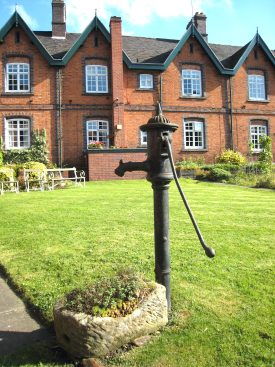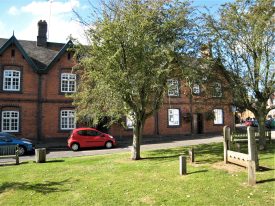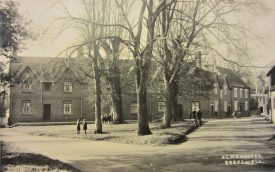Berkswell has a row of almshouses centrally located on the village green; they were built to replace parish poor houses.
The original charity
In 1589 parishioners complained that the Lord of the Manor was not using rents from property given to support the poor for the purpose intended. As a result, the Church and Poors Land charity was set up and managed by the Church. Originally poor people were offered rent-free accommodation in parish poor houses scattered about the village and surroundings; by 1830 there were 32 of these cottages. Beneficiaries were not allowed to be in receipt of parish poor relief, but this proved unduly restrictive and by 1874 the people living in the almshouses were receiving poor relief.1
The buildings
Three cottages were built in 1829-30 and a row of 12 almshouses were purpose built in Church Lane of red brick in 1856. Two of the older cottages were retained making a total of fourteen units; today there are ten.
In the 1850s there were two acres of lawn and vegetable plots for the 32 cottagers.2 Now there is a communal garden behind the almshouses with a water pump (now disused) and outbuildings. A charming little museum was set up in these outbuildings but sadly it has closed.
The residents
Residents were to be aged poor widows or widowers or couples. They lived in the almshouses rent-free. In 1911 there were nine people living there: a married couple (the husband a former agricultural labourer); five widows and two spinsters. Nearly half had been born in Berkswell. Mrs Hannah Dale was a 60-year-old widow who had born eight children in Berkswell. Miss Mary Ann Stain was 55 years old and had been totally deaf since the age of 27. Miss Emma Beecham was 58 years old, illiterate and still working as a school caretaker.3
Churchwardens in trouble!
Parishioners complained that the churchwardens were spending income on new pews rather than the poor in the mid 18th century.4
References
1 White, F. & Co., History Gazetteer, and Directory of Warwickshire, Sheffield, 1874, p. 585.
2 White, F. & Co., History Gazetteer, and Directory of Warwickshire, Sheffield, 1850, p. 861.
3 1911 census, Nuneaton, RG386/2/3 pp. 123-139.
4 Charity Commissioners’ Reports for Warwickshire, 1815-35, pp. 639-4.










Comments
Add a comment about this page